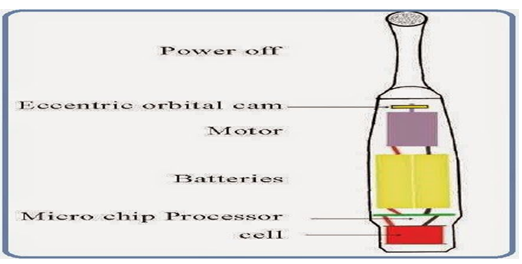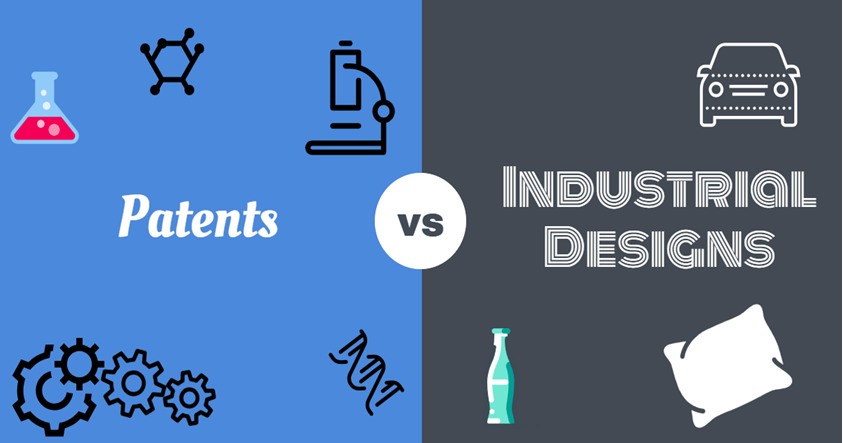Introduction What is Artificial Intelligence? Creating computer systems capable of carrying out activities that need…
What Are The Differences Between The Protection Of An Invention And An Industrial Design?
INTRODUCTION
In everyday life, we use so many products of different brands, inventions that are created by human mind called as Intellectual Property. Patents and Designs are the subsets of Intellectual Property and many a times we are bound to confuse between them. But these two vary from each other completely. A design protection and a patent protection are two different things.

Hence, there is a difference between Utility patent and Design patent. The former protects the functionality/ utility of the invention whereas the latter protects the outer look or appearance. The term of protection for the utility patent is 20 years from the date of application and for the design patent is 14 years from the application date.
PROTECTION OF AN INVENTION (PATENTS)
Patent rights are exclusively given to those whose inventions are granted that involve technical procedure/ technical features, stated by World Intellectual Property Organization (WIPO). Once patent rights are acquired by an inventor, he can exclude others from using his/her invention for a given period of time.
INDUSTRIAL DESIGNS
Industrial Designs are nothing but shape, configuration, pattern or ornament or composition of lines or colour or combination thereof applied to any article whether two dimensional or three dimensional, by any industrial process or means, whether manual, mechanical or chemical, separate or combined, which in the finished article appeal to the eye. The design of a product, along with providing an attractive character to the article, provides and promotes economic development by acknowledging and encouraging creativity in the manufacturing or industrial sector.
Industrial Design builds innovation, creativity of human mind. Forms and features of productsplay a huge role in determining the success of the business in this sector. Industrial Designs come into effect by combining the art, business and groundwork to get the desired outcome. For example, the aesthetic appealing products like mobile phone, a table or a car are the best possible outcomes of an Industrial Design.
DIFFERENCES BETWEEN PROTECTION OF AN INVENTION AND AN INDUSTRIAL DESIGN
| Particulars | ‘invention’ Patents | Designs |
| What is protected | Technical functionality/inventions | Aesthetic aspect
outer look/appearance |
| Who is eligible | Inventors | Inventors and Designers |
| Criteria considered | Novelty
Utility Non-obviousness |
New/original
Non-functional |
| Duration of Protection | 20 years | 10 years+ extension of 5 years=15 years. |
| Nature of procedure | Very expensive | Less expensive |
| Nature of enforcement | Territorial | Territorial in nature |
| Examples | Invention of the soft drink, its chemical component, formula and method | Unique Shape or outer appearance of the soft drink, its outlook/pattern |
Further, these two types of Intellectual Property are governed by separate statutes in India. Patents are governed by The Patent Act, 1970 as amended by the Patents (Amendment) Act, 2005 and the Patents Rules, 2003 whereas, industrial design are governed under the Designs Act, 2000. Both patents and industrial designs are registered through the Office of the Controller General of Patents, Designs & Trademarks.
WHY SHOULD YOU PROTECT YOUR INDUSTRIAL DESIGNS
The main essence to protect any form of Intellectual Property in India is its ‘Originality’. When a person invents something from the scratch by putting in so much hard work without copying, he/she is eligible to protect his/her ideas.
By registering industrial design as per the provisions of the act, the creator gets the exclusive right to utilize the design and protect it from any exploitation. In India, a registered design is enforced through civil action. The remedies against infringement are inclusive of interim and permanent injunctions as well as damages.
The Civil action for the design infringement is filed before the district court having jurisdiction where the defendant resides or where the registered place of business is located.
In the event the court does not grant a judgment in favor of the plaintiff, he/she can approach the appellate court for grant of injunction in the case of design infringement. The defendant can also approach the appellate court if he feels an injunction has been granted wrongly.
Following are the few advantages on protection of the invention:-
- Exclusive/Absolute rights: – The Creator/owner of such design has absolute right in law for at least 10 years against any unauthorized use of such designs by the third party.
- Brand reputation: – It increases the value of a company’s brand name.
- Commercial exploitation: –Protection helps in exclusive usage and can be sold/licensed to another enterprise which will give monetary returns to the creator/owner of the designs.
- Encourages Creativity: – By Protecting the Industrial design, it encourages creativity, leading to more creative products.
- Legal rights: –Protection of the design gives the Owner of the design the legal right to Sue, seek damages, injunction etc if anyone utilizes his/her design without prior permission.
DISADVANTAGES OF NON-PROTECTION
Any design which is unregistered under the Act cannot be enforced by the law. The Act provides for protection only after the design is registered. One cannot seek protection for an unregistered design as per the law. This will affect the market value of the brand name of the company.
CASELAW
Cello Household Products v Modware India &Ors,
FACTS
Cello Household Products (“Cello”),were manufacturing and selling a unique water bottle “PURO” with a two-tone colour scheme, flip top and unique surface pattern in a distinctive packaging with a priority date of 12th May 2016. In January, 2017 Cello came upon Modware India’s (“Modware”) bottle under the name “KUDOZ which was quite similar to packaging of “PURO”. On becoming aware, Cello filed a suit against Modware seeking injunction on two grounds: one being that Modware is selling a product (KUDOZ) with the same design as Cello’s PURO, which is an infringement of its registered design, and secondly that the KUDOZ bottles sold by Modware would mislead the public into thinking they were associated with Cello, thereby leading to passing off.
ISSUE
Whether there exists any design infringement and passing off in relation to packing of the water bottle?
CONTENTION BY CELLO:
Cello (the plaintiff) contended that their product has a unique innovative, original and novel design.
- The feature of novelty in “PURO” Bottle design resides inter alia in its overall shape, configuration and surface pattern making the said design aesthetically appealing and attractive. The configuration of the bottle is such that it appears as if the body of the bottle is divided into separate parts;
- The surface pattern of the bottle has a unique type of oval/egg shape curve, which looks aesthetically attractive.
- Unsymmetrical places reversed oval graphics on main body gives contemporary and unique impression to a bottle. Interplay of stepped up and stepped down surfaces creates unique surface pattern.
- Minimal yet clean and bold graphic in the elements makes PURO Bottle stand out in the cluttered marketplace/against the competition.
- The flip cap of the bottle also appears that it has divided into two parts.
- The surface of bottle has a shining effect, which gives elegant effect to the PUROBottle. The main body of the PURO bottle and alsoits cap contains a unique colourcombination of two colours.
CONTENTION BY MODWARE
Modware’s defense is that “a bottle is a bottle, by whatever name called”. It is a container of liquid. Generally, it is taller than wider. Modware makes very many bottles. So do others. They relied upon images of Modware’s various bottles and those of other manufacturers saying all these are just bottles. Therefore, according to them, there is neither novelty nor originality in Cello’s claim as to ‘shape’ or ‘configuration’. Others have also made tall cylinders with screw top or flip top lids. Cello can claim no originality in these. Modware claims that the shape of the PURO bottle is “the natural shape of any bottle” and this is millennia old.
JUDGMENT
The High Court compared the two products PURO and KUDOZ and held in favour of Cello thereby restraining Modware from infringing and in any manner passing off Cello’s registered designs in water bottles on the basis of design infringement, passing off. The court held that the two products were so similar that they were likely to cause confusion in the minds of consumers. The possibility of confusion is the only relevant factor. The likelihood of damage is also deemed to have been fulfilled.
WHY SHOULD YOU PROTECT YOUR INVENTION
A Patent is a territorial right, that is- it gives the owner of the patent the right to exclude others from making same kind of product and selling it.
The inventors and their assignees will have to file different or separate patent applications in countries of their interest, along with necessary fees for obtaining patents in those countries.
A Patent can only be obtained in respect of products and processes not concerning services. In order to be patentable an invention must meet three (3) requirements.
- Novelty
- Non-obviousness
- Industrial application.
An Inventor, his assignee or a legal representative can apply for the Patent for the protection of their invention. According to Sec.2 of the Patents Act, 1970, anything that is novel, has commercial value and has some purposeful utility can be patented. A mere discovery or a scientific theory cannot be patented. Even any artistic work related to literary, dramatic, and musical cannot be patented. Any natural thing / materials that already exist in nature are non-patentable.
CONCLUSION
Utility Patents has a time period of 20 years of protection whereas the Design Patents is protected for 15 years from the date of filing of an application. But utility patents consume more time compared to the design patents. Acquiring a patent can easily take up to 3-5 years or even longer in case of any opposition is filed against the application/ depending on the backlog of applications in the patent office. A Design patent can take approximately 1-2 years.
The competitors in the market can easily infringe the design patent by making a few changes here and there. This way they try to deceive the public into buying the products. Design being an appearance of an invention can be easily copied. Whereas the utility patents are difficult in nature as they claim the technical functionality of an invention. Still, dupes can be made of a patented product and it can still infringe the utility patent.
For example, the formula used in a skin moisturizer which is patented, the competitor can easily dupe the components and make a similar product in nature.Therefore, it is always strongly suggested to keep in mind few things while selecting designs for the product.
Author: Valli Rachana – an intern at Khurana & Khurana, Advocates and IP Attorney, in case of any queries please contact/write back to us via email vidushi@khuranaandkhurana.com.




